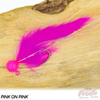Product Description
Custom built on Jig Geek 1/4oz blanks by the very people that fish them, these multi-purpose jigs are fabulous for drifting under a float in faster waters, or twitching in softer water for salmon and steelhead.
About Twitching for Salmon and Steelhead
Twitching jigs is a popular fishing technique used for targeting salmon and steelhead in rivers and streams. It involves using a specialized type of jig and imparting an erratic, twitching action to grab the fishes attention and curiousity. This technique can be effective in triggering aggressive strikes from these powerful and migratory fish.
Salmon are often territorial, getting super aggressive towards anything that bugs them.
Here's how to twitch jigs for salmon, steelhead and bulltrout:
Equipment and Setup
- ROD & REEL: Choose a fast action medium to medium-heavy spinning rod and reel combo capable of handling the weight of the jigs and the strength of salmon and steelhead. A 7' - 9' rod with a sensitive tip is ideal for detecting subtle strikes. The faster action tip will allow you to make subtle twitches of the jig without ripping it up and out of the strike zone too quickly.
For the salmon enthusiast, we also off rods specifically designed for twitching. - LINE: Use a braided mainline for increased sensitivity and better control over the jig's movement. Connect a fluorocarbon leader of around 2 to 4 feet in length to the mainline using a strong and reliable knot.
- JIGS: Select jigs designed for twitching. These jigs are often marabou, rabbit fur, or feathered jigs tied on jig heads with a hook. The size will depend on the depth and flow of the water. In calmer backwaters or pools, 1/4oz jigs are often sufficient or preferred, while faster moving water will require a heavy jig that can get down quick.
Colour depends on the species and the mood the fish are in, and clarity of the water. Some species of salmon are all over the map when it comes to colour. Which is why having a broader selection of colours and sizes in your arsenal can be the difference between getting skunked and bringing home a trophy for the bbq.
Technique
- Casting: Cast your jig slightly upstream and allow it to drift naturally downstream while maintaining slight tension on the line. This mimics the movement of a wounded or struggling prey.
- Twitching Action: After the cast, let the jig sink for a moment, then start imparting a twitching action. Gently twitch your rod tip upwards, causing the jig to dart and swim erratically. Vary the intensity and rhythm of your twitches to imitate the movement of a distressed fish.
- Retrieve: As the jig moves downstream, continue twitching and occasionally pausing to let the jig sink. Salmon and steelhead often strike during the pause, believing the jig to be an easy target.
- Experiment: Different days and water conditions may require different techniques. Be prepared to adjust your twitching technique, retrieve speed, and jig color to find what works best on a given day.
- Depth Control: Vary the depth at which you present the jig by adjusting the weight of the jig or using a sink-tip line. This allows you to cover different parts of the water column where salmon and steelhead might be holding.
Remember that twitching jigs requires practice and patience. It's important to stay attuned to the behavior of the fish and adapt your technique accordingly. Pay attention to local regulations, fishing seasons, and any special restrictions that may apply to the water you're fishing in.













